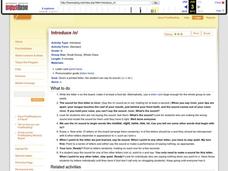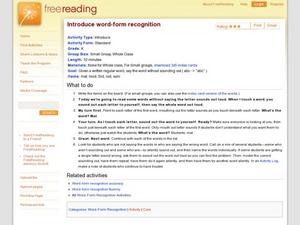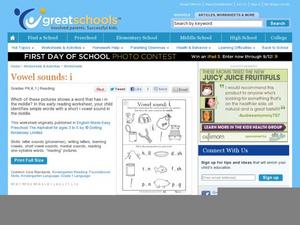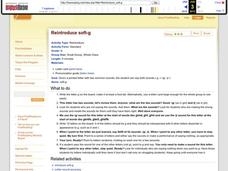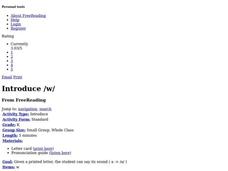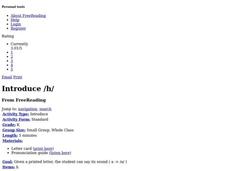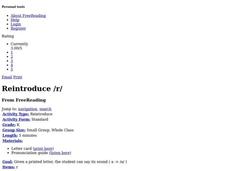Curated OER
Reintroduce /x/
What words end with /x/? Unite several alphabet concepts as scholars learn all about the letter x. After identifying it, they listen to you pronounce the /x/ sound and try it themselves (use these tips to explain how you do this)....
Curated OER
Reintroduce /v/
Combine letter recognition, sound, and pronunciation using this strategy for pre-readers. Use these letter cards or write the letter v on the board, asking scholars to identify it. Then, model the /v/ sound as you explain how you...
Curated OER
Reintroduce an Irregular Word
Some words are tricky. Can your scholars quickly recognize irregularly spelled words? Write the word was on the board (or any irregular word you'd like to practice), touching each letter as scholars segment the phonemes. Explain that the...
Curated OER
Odd Ones Out
Some of these words don't rhyme; scholars determine which ones as they examine four sets of images with the vowel sound /e/. For each set, they circle the words that don't rhyme with the first image. Be sure kids know what these images...
Curated OER
Introduce /p/
Navigate the letter p without leaving anything out: combine pronunciation, recognition, letter sound, and word examples. Scholars examine the letter shape and listen to you pronounce the /p/ sound. As you explain how this sound is made,...
Curated OER
Introduce /y/
As you come to an end in your alphabet study, use these strategies to examine the letter y. Scholars examine the letter shape and listen to you pronounce the /y/ sound. Use these tips to explain how you do it as they try. Can they think...
Curated OER
Introduce /n/
What is this letter? Once your class is ready to explore the letter n, use these strategies to combine word examples, pronunciation, and letter recognition. First, can they identify the letter? Make the /n/ sound, explaining how you do...
Curated OER
Reintroduce /o/
There are many words that begin with the /o/ sound; scholars study this letter in multiple contexts including intial phoneme examples, pronunciation, and letter recognition. Write the letter on the board to see if learners can identify...
Curated OER
Introduce Word-Form Recognition
Sound out sight words using these word cards and word-form recognition strategies. As you point to each word, scholars sound out the letters silently instead of segmenting the sounds aloud. Show them how you do this by mouthing the...
Curated OER
Introduce /j/
Learn the ins and outs of the letter j using these strategies combining pronunciation, recognition, letter sound, and word examples. Scholars examine the letter shape and listen to you pronounce the /j/ sound. Use these tips to explain...
Curated OER
The ee and ie Sounds
Put to use the old saying, "When two vowels go a walking, the first one does the talking." Scholars focus on the /ee/ and /ie/ sounds and spelling patterns that create them. First, they label four pictures with the ea and ee spellings,...
Curated OER
The ee Sound
When two vowels take a walk, the first one does the talking! Scholars see this motto put to use as they study the /ee/ sound in various spelling patterns. Learners read a short introduction on this concept before reading several example...
Curated OER
The ai and ar Sounds
These words sound the same but are spelled differently, giving scholars a chance to practice spelling patterns and rhyming words. First they read that the /ai/ vowel sound can be made with three different spellings. Learners label three...
Curated OER
Vowel Sound: i
As scholars become more comfortable with initial sound correspondence, introduce them to medial sounds. As they focus on the vowel sound /i/, youngsters examine a set of images and draw a line from the letter i to any with that middle...
Curated OER
Reintroduce Soft-g
Do your scholars know that the letter g sometimes steals the j phoneme? Explore the letter g using these strategies combining pronunciation, recognition, letter sound, and word examples. Scholars examine the letter shape and listen to...
Curated OER
Introduce /w/
Get to know the ins and outs of the letter w using these strategies combining pronunciation, recognition, letter sound, and word examples. Scholars examine the letter shape and listen to you pronounce the /w/ sound. Use these tips to...
Curated OER
Introduce /h/
Explore the letter h using these strategies combining pronunciation, recognition, letter sound, and word examples. Scholars examine the letter shape and listen to you pronounce the /h/ sound. As you explain how this sound is made, they...
Curated OER
Reintroduce /r/
The /r/ sound can be a difficult one, but scholars use some helpful tips to get it right. After examining the letter shape they listen to you pronounce this phoneme and describe what you are doing to create the sound. They try on their...
Curated OER
Introduce /d/
Give youngsters a better grasp of the letter d by combining letter sounds, pronunciation, recognition, and word examples. Scholars examine the letter shape then listen to you make the /d/ sound and try it on their own. Kids brainstorm...
Curated OER
Reintroduce /b/
Combine letter sounds, pronunciation, recognition, and word examples in one exercise by following these strategies. Scholars examine the letter b and identify it if they can. As they listen to you make the /b/ sound, youngsters try it...
Curated OER
Introduce /u/
As scholars are learning about letter sound correspondence use this activity to help them with the /u/ sound. Learners examine a large u on the board, identifying it if they can. They listen to you make its sound, explaining to them what...
Curated OER
O
As part of a series of alphabet worksheets, learners focus on the letters p and o. They begin by tracing the lowercase letters, using the space to print a few on their own. Next, scholars connect the letter to images that begin with the...
Curated OER
-air Spelling Pattern
What do hair, chair, and fair all have in common? The -air spelling pattern! Each slide provides both an image and a word that contains the -air sound. Perfect for early readers or to boost spelling success.
Curated OER
Reintroduce /e/
These inventive strategies help emerging readers focus on the letter e, forming sound associations along with letter recognition. Explain the mouth movement in making the /eee/ sound, asking learners to try it. Can they think of words...








